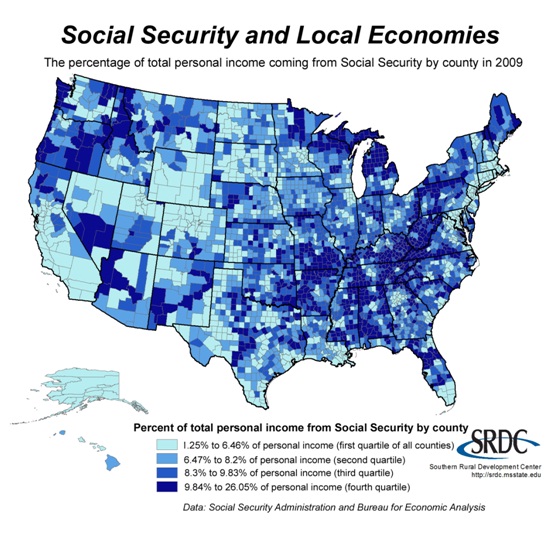Jennifer Clark, National Academy of Social Insurance
The Center for Rural Strategies, an awardee of NASI’s Improving Lives of Vulnerable Americans Through Social Security project, recently analyzed Social Security recipients by county in the U.S. The Daily Yonder (affiliated with the Center for Rural Strategies) used this breakdown of Social Security beneficiaries to find the counties most dependent on Social Security. The project found that 9.3 percent of total personal income in rural counties came from Social Security payments in 2009, compared to urban counties, where 5.0 percent of total income came from monthly Social Security payments. Social Security is particularly important to these rural communities because the money received from benefits is largely spent in the community.
Visualizing the importance of Social Security to local economies, the map below shows the percentage of total personal income coming from Social Security benefits for each county in the US. The darkest blue represents counties where Social Security makes up almost 10 percent or more of total personal income.

Click on the map for a larger view.
While the map provides a visually arresting overview of how critical Social Security is to many regions across the U.S. (note the dark blue cluster around Appalachia), the numbers from specific counties present a deeper understanding of how Social Security benefits affects local economies. Here are a few examples from the project:
- In Douglas County, MN, Social Security represents 8.4 percent of total personal income in the county, emphasizing that Social Security payments are particularly important to rural counties and small cities because these benefits are then spent in the community.
- In Halifax County, VA, Social Security beneficiaries represent 28.7 percent of the total county population and Social Security totals 11.3 percent of all personal income in the county.
- In Weakley County, TN, Social Security payments have been changing over time as a proportion of total income, reflecting a general trend toward aging populations in rural communities. These payments amounted to 6.1 percent of total income in 1970, 8.5 percent in 1980, 7.9 percent in 1990, 7.9 percent in 2000, and 9.3 percent in 2009.
- Orangeburg County, SC, would have lost $232 million of its total personal income – about 8.6 percent – if local Social Security recipients didn’t receive their monthly benefits.
For more information on this project, the Center for Rural Strategies has data tables, maps, and charts available online, along with a description of the project on their website.

Does the study make
Does the study make distinction between beneficiaries of SSDI vs SS Retirement?
Hi Glenn,
I believe the data
Hi Glenn,
I believe the data includes both disability, survivor, and retirement benefits. A more in-depth discussion of the data can be found in this blog post on the Daily Yonder:
http://www.dailyyonder.com/rural-more-dependent-social-security/2011/10/29/3578
“Social security payments come in three forms: an old-age pension, a survivor benefit or a disability check. Nationally, 16.7 percent of the population in 2009 received some form of monthly Social Security payments. …In rural counties, however, 23.6 percent of residents receive at least one of these three Social Security benefits. In small cities, 21.2 percent of residents receive a Social Security check.”
For more questions about the data and methodology, I would refer you to Bill Bishop at the Daily Yonder/Center for Rural Strategies and Dr. Roberto Gallardo, a research associate with the Southern Rural Development Center at Mississippi State University, who compiled the data and wrote the findings.
Best,
Jennifer
Also, this table breaks down
Also, this table breaks down beneficiaries by each form of Social Security: http://srdc.msstate.edu/socialsecurity/statetable.html